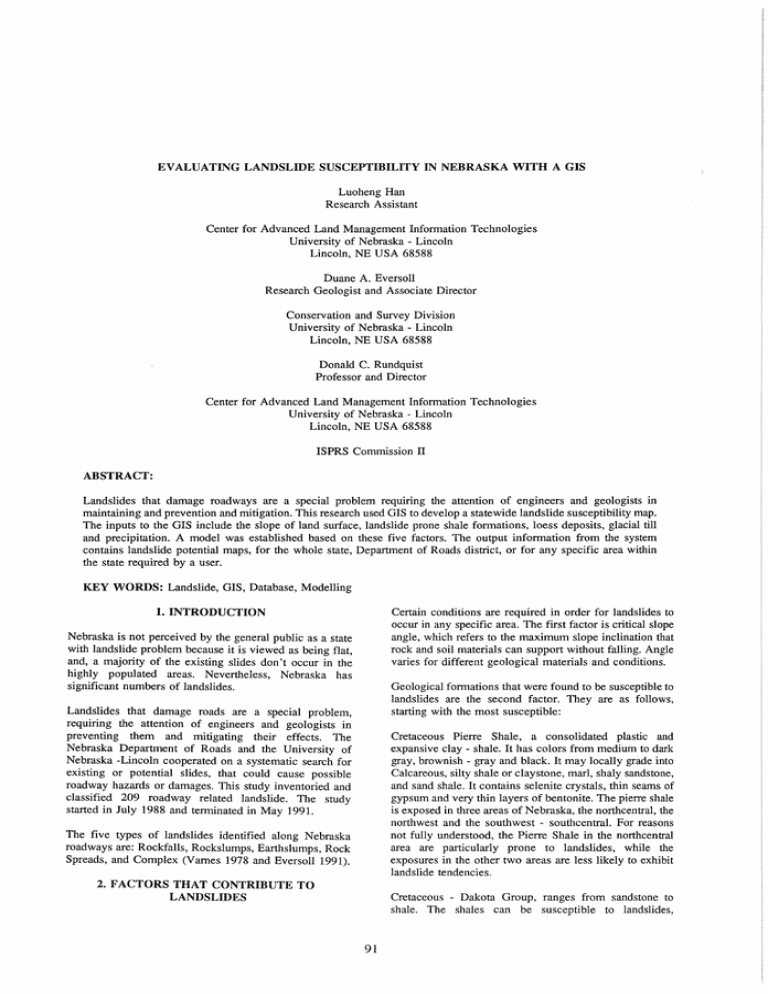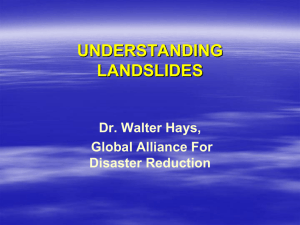EVALUATING LANDSLIDE SUSCEPTIBILITY IN NEBRASKA WITH A ... Luoheng Han Research Assistant
advertisement

EVALUATING LANDSLIDE SUSCEPTIBILITY IN NEBRASKA WITH A GIS Luoheng Han Research Assistant Center for Advanced Land Management Information Technologies University of Nebraska - Lincoln Lincoln, NE USA 68588 Duane A. Eversoll Research Geologist and Associate Director Conservation and Survey Division University of Nebraska - Lincoln Lincoln, NE USA 68588 Donald C. Rundquist Professor and Director Center for Advanced Land Management Information Technologies University of Nebraska - Lincoln Lincoln, NE USA 68588 ISPRS Commission II ABSTRACT: Landslides that damage roadways are a special problem requiring the attention of engineers and geologists in maintaining and prevention and mitigation. This research used GIS to develop a statewide landslide susceptibility map. The inputs to the GIS include the slope of land surface, landslide prone shale formations, loess deposits, glacial till and precipitation. A model was established based on these five factors. The output information from the system contains landslide potential maps, for the whole state, Department of Roads district, or for any specific area within the state required by a user. KEY WORDS: Landslide, GIS, Database, Modelling 1. INTRODUCTION Certain conditions are required in order for landslides to occur in any specific area. The first factor is critical slope angle, which refers to the maximum slope inclination that rock and soil materials can support without falling. Angle varies for different geological materials and conditions. Nebraska is not perceived by the general public as a state with landslide problem because it is viewed as being flat, and, a majority of the existing slides don't occur in the highly populated areas. Nevertheless, Nebraska has significant numbers of landslides. Geological formations that were found to be susceptible to landslides are the second factor. They are as follows, starting with the most susceptible: Landslides that damage roads are a special problem, requiring the attention of engineers and geologists in preventing them and mitigating their effects. The Nebraska Department of Roads and the University of Nebraska -Lincoln cooperated on a systematic search for existing or potential slides, that could cause possible roadway hazards or damages. This study inventoried and classified 209 roadway related landslide. The study started in July 1988 and terminated in May 1991. Cretaceous Pierre Shale, a consolidated plastic and expansive clay - shale. It has colors from medium to dark gray, brownish - gray and black. It may locally grade into Calcareous, silty shale or claystone, marl, shaly sandstone, and sand shale. It contains selenite crystals, thin seams of gypsum and very thin layers of bentonite. The pierre shale is exposed in three areas of Nebraska, the northcentral, the northwest and the southwest - southcentral. For reasons not fully understood, the Pierre Shale in the northcentral area are particularly prone to landslides, while the exposures in the other two areas are less likely to exhibit landslide tendencies. The five types of landslides identified along Nebraska roadways are: Rockfalls, Rockslumps, Earthslumps, Rock Spreads, and Complex (Varnes 1978 and Eversoll 1991). 2. FACTORS THAT CONTRIBUTE TO LANDSLIDES Cretaceous - Dakota Group, ranges from sandstone to shale. The shales can be susceptible to landslides, 91 data provided by the Department of Agricultural Meteorology at the University of Nebraska - Lincoln. especially in poorly drained and wet areas. Cretaceous - Greenhorn Limestone and Greenhorn Shale. Failures in the Greenhorn are mostly classified as rockfalls and usually occur when the underlaying Groneros shale is eroded leaving under-cuts or overlaying of Greenhorn Limestone which eventually fails. 3.2 Modelling Using the five factors noted above, a model for evaluating landslide susceptibility was established. Each input parameter has its associated weight, range, and rating, which are combined to produce a final score for the site concerned. Tertiary - Arikaree Group, sandy siltstones, underlain by fine - coarse grained sandstones. Landslides typically occur in steep slopes or escarpments in the North Platte Valley in western Nebraska and in the Pine Ridge area at Northwestern Nebraska. Every factor was evaluated with respect to the other factor to determine relative importance, which was expressed by a numerical weight of 1 to 3, with 1 having the least effect on landslide potential and 3 having the most (Table Miocene - Ogallala Group,silt, sand, sandstones, siltstones and conglomerates. Failures in the Ogalla were mostly classified as rockfalls in areas of steep roadway slopes. 1). 3.3 The output information The third factor important in landslide development is loess deposits, linked to the most widespread problem areas in Nebraska. These windblown deposits (silt to very fine sand) usually have a low density and are fairly permeable. Loess will readily absorb large amounts of precipitation. Landslide problems occur wherever the loess overlies a denser more compact deposit or buried soil. The output information was a statewide landslide potential map (scale 1:1,900,800) and a series of the 8 Nebraska Department of Roads district maps (scale 1:315,000). These landslide susceptibility maps use color symbols to differentiate between low and high landslide potential areas. The GIS also has the capability to produce raster maps for any specific area within the state required by a user. The fourth factor is glacial tilL Glacial materials are found only in the eastern 1/4 of the state. Slides and slumps are likely to occur where the tills are overlain by unconsolidated younger materials (sand and gravel, loess, etc.). The unconsolidated tills are barriers to the downward movement of water. The water moves along these interfaces and may cause failures where glacial tills emerge on exposed slopes or roadway cuts. Table 1. Assigned weights for the factors Factor The last factor is precipitation. Precipitation causes an increase in the water level and an increase in the porewater pressure within the rock or soil. This action greatly reduces the shearing strength of the soil. This same water or an increase in moisture content adds weight to the mass and may lubricates the slip planes. These actions increase the chance for downslope movement of the landslide mass. Weight Slope of land surface 3 Shale formations 2 Loess deposits 2 Glacial till Precipitation 4. REFERENCES 3.EVALUATING LANDSLIDE POTENTIAL WITH A GIS Eversoll, D., 1991. Landslide inventory along Nebraska state - federal roadway system. Final report RESI (0099) P 429 (not released), Supplemental agreement v between Nebraska Department of Roads and The University of Nebraska, Lincoln, NE-USA. pp. 2-15. 3.1 Database The maps of geologic formations, loess deposits, and glacial till distribution, provided by the Conservation and Survey Division, University of Nebraska - Lincoln, were digitized as vectors format and then converted into raster formatted data. Slope data were derived from U. S. Geological Survey Digital Elevation Model (DEM) and Digital Line Graphs (DLG). Slope is defined by a plane tangent to the surface as modelled by the gradient, the maximum rate of change of altitude and aspect, and the compass direction of this maximum rate of change. The precipitation map (annual precipitation) was derived from Varnes, D., 1978. Slope movement types and processes, in: R. L. Schuster and R. J. Krizek [eds.], Landslide, analysis and control: National Research Council, Transportation Research Board. Special report 176. Washington, D. c.-USA. pp. 11-13. 92







